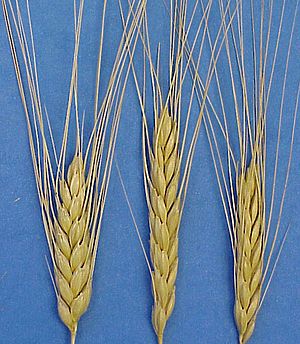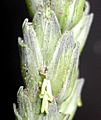Wheat facts for kids
Quick facts for kids Wheat |
|
|---|---|
 |
|
| Scientific classification |
|
| Kingdom: | Plantae |
| Clade: | Tracheophytes |
| Clade: | Angiosperms |
| Clade: | Monocots |
| Clade: | Commelinids |
| Order: | Poales |
| Family: | Poaceae |
| Subfamily: | Pooideae |
| Tribe: | Triticeae |
| Genus: | Triticum L. |
| Species | |
References: |
|
Wheat is a type of cereal grain. It's one of the most important food crops in the world! People often eat wheat in the form of bread, but it's also used to make many other foods.
Wheat is a kind of grass plant. Its "fruit" is a head of wheat, which contains edible seeds. These seeds are what we call wheat grains. Wheat was first grown in a region called the Levant in the Near East. Today, it's grown all over the world.
Wheat is super important for global trade, even more than all other crops combined. It's the main source of plant-based protein in human food worldwide. Wheat has more protein than other major cereals like maize (corn) or rice. In terms of how much is produced, wheat is second only to rice as a main human food crop. About 800 million tons of wheat are harvested every year!
Wheat played a huge role in the start of civilization. It was one of the first crops that could be easily grown on a large scale. Its seeds could also be stored for a long time in dry places. This helped ancient cities grow in the Fertile Crescent, including the Babylonian, Assyrian, and Persian empires.
Wheat grain is a basic food used to make flour. This flour is then used for many things like bread (leavened, flat, and steamed), biscuits, cookies, cakes, breakfast cereals, pasta, noodles, and couscous. Wheat can also be used to make ethanol, which is found in alcoholic drinks or used as biofuel.
Some people have an allergy to wheat, which can cause a condition called coeliac disease. If someone with coeliac disease eats food containing wheat, they might get diarrhoea and feel unwell.
Contents
What Wheat Looks Like
The wheat plant has long, thin leaves. Its stems are usually hollow. At the top of the plant, there are "heads" that contain many small flowers, usually between 20 and 100. These flowers are grouped together in small clusters called spikelets. Each spikelet has two to six flowers. In most spikelets, two or three of these flowers are fertilized, and these are the ones that produce the grains we eat.
Types of Wheat We Grow
All the types of wheat we grow today have more than the usual number of chromosomes. This happened naturally over time. When a wheat plant had more chromosomes, its "ears" (the part with the grains) became larger. Farmers then chose these plants with bigger ears to grow more of them. This is how we got all the different kinds of cultivated wheat we have now. Here are a few examples:
Wheat with Six Sets of Chromosomes
- Common wheat or Bread wheat (T. aestivum): This type has six sets of chromosomes and is the most widely grown wheat in the world. It's what most bread is made from.
- Spelt (T. spelta): This is another type with six sets of chromosomes, but it's grown in smaller amounts. Spelt is very similar to common wheat.
Wheat with Four Sets of Chromosomes
- Durum (T. durum): This is the only type of wheat with four sets of chromosomes that is widely used today. It's the second most grown wheat and is often used to make pasta.
- Emmer (T. dicoccon): This wheat also has four sets of chromosomes. It was grown a lot in ancient times, but it's not widely used anymore.
Wheat with Two Sets of Chromosomes
- Einkorn (T. monococcum): This type has the normal two sets of chromosomes. It has both wild and cultivated versions. Einkorn was one of the first wheats to be grown by humans, but it never became as important as emmer wheat.
Emmer Wheat: An Ancient Grain
Emmer wheat (Triticum dicoccum) is also known as 'hulled wheat'. It was one of the very first crops that humans started to grow in the Near East. It was grown a lot in the ancient world. Today, it's mostly found in small amounts in mountainous areas of Europe and Asia.
In the wild, emmer wheat has special bristles called awns on its spikelets. These awns help the seeds dig into the soil. At night, when it's humid, the awns stand up straight and pull together, pushing the grain into the soil. During the day, when it's drier, the awns relax. This up-and-down movement helps the spikelet drill itself up to an inch into the ground over a few days and nights.
Einkorn Wheat: One of the Earliest Wheats
Einkorn wheat (Triticum monococcum) is one of the earliest types of wheat that humans started to grow. Grains of wild einkorn have been found at very old sites from the Paleolithic Age in the Fertile Crescent. It was first grown by people around 7500 BC, which is about 9,000 years ago, during the early Neolithic period.
Scientists have studied DNA and believe that einkorn was first grown in southeast Turkey. This area is where many early farming villages have been found. Growing einkorn became less common during the Bronze Age. Today, it's rarely planted, but it has become popular again as a healthy food. It's still used to make bulgur (cracked wheat) or as animal feed in mountainous areas of France, Libya, former Yugoslavia, Turkey, and other countries. Einkorn can often grow well in poor soils where other types of wheat would not survive.
Einkorn was first grown around the same time as emmer wheat, but it never became as important.
Related Pages
Images for kids
-
Wheat harvest in Idaho, United States
-
Young wheat crop in a field near Solapur, Maharashtra, India
-
Wheat farm in Behbahan, Iran
-
A combine harvester threshes the wheat, crushes the chaff, then blows chaff across the field. The combine loads the threshed wheat onto a trailer while moving.
See also
 In Spanish: Trigo para niños
In Spanish: Trigo para niños


















